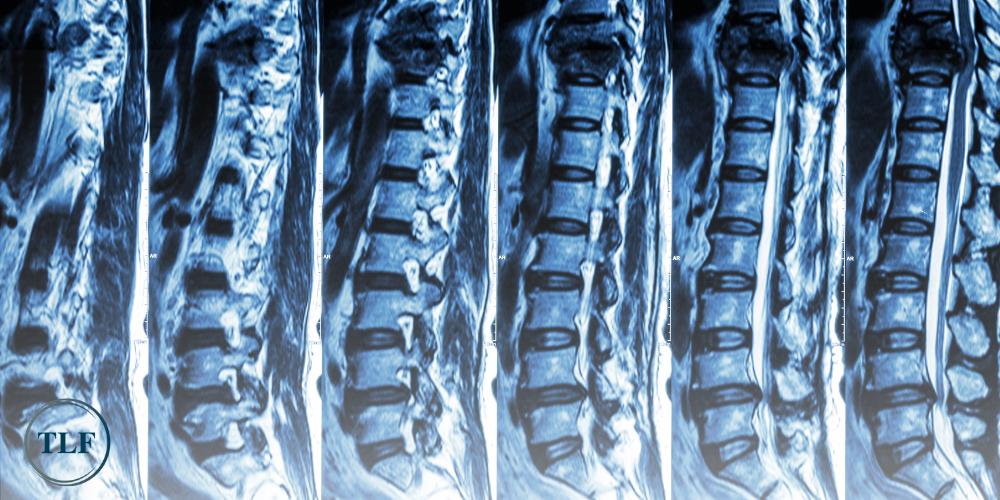Putting Our Knowledge And Experience To Work
Home » Medical Malpractice » Medical Malpractice Spinal Cord Injuries
Medical Malpractice Spinal Cord Injuries
Ohio and Northern Kentucky Malpractice Attorneys for Spinal Cord Injuries Caused By a Physician’s Negligence
At TLF: The Medical Injury Law Firm, our dedicated team of Ohio and Northern Kentucky medical malpractice attorneys is committed to providing compassionate legal guidance for those who have suffered spinal cord injuries due to medical malpractice.
With a deep understanding of the complexities of medical injury law and a steadfast commitment to our clients, we work tirelessly for justice and compensation. Our experience in navigating the intricate legal and medical aspects of these cases positions us as a top choice for injury victims and their families seeking recovery and restitution. To learn more about how our Ohio and Northern Kentucky medical malpractice attorneys can help, call us toll-free at (800) 698-4054 to schedule a free consultation.

Understanding Spinal Cord Injuries
The spinal cord, an integral part of the central nervous system located within the vertebral column, extends from the brainstem to the lower back. Composed of nerves and supporting cells, it facilitates communication between the brain and body, regulating movement, sensation, and autonomic functions like breathing and temperature control.
Most spinal cord injuries result from a traumatic impact to the spine, causing fractures, dislocations, or compression of the vertebrae. These injuries vary in severity, from mild dysfunction to severe disabilities like paralysis (quadriplegia/tetraplegia or paraplegia), sensation loss, and impaired organ function. The injury’s severity and location on the spinal cord dictate the extent of its impact, with higher spinal column injuries often leading to more extensive paralysis.
Types of Spinal Cord Injuries
Spinal cord injuries are either complete injuries that lead to total loss of sensory and motor function below the injury site, causing widespread paralysis, or incomplete injuries where the person retains some function, with the degree varying. The injury’s location on the spinal column determines the extent of paralysis. Injuries to the lower spine often cause paraplegia, affecting the lower limbs, whereas cervical (neck) injuries lead to quadriplegia, paralyzing all four limbs. The severity of quadriplegia can range from partial to total paralysis and may affect respiratory function, necessitating extensive care.
Types of spinal injuries include:
- Compression Injuries: where the spinal cord is compressed due to pressure from bone or disc material
- Contusion or Bruising of the Spinal Cord: often caused by trauma leading to swelling and temporary dysfunction
- Lacerations or Tears: severe injuries where the spinal cord is partially or fully severed
- Central Cord Syndrome: typically involves damage to the central part of the spinal cord, affecting arm movement and sensation more than the legs
- Anterior Cord Syndrome: results from injury to the front of the spinal cord, affecting motor and sensory pathways
- Posterior Cord Syndrome: involves damage to the back of the spinal cord, impacting proprioception (sense of self-movement and body position)
- Cauda Equina Syndrome: occurs when the nerve roots at the lower part of the spine are compressed, affecting leg movement and bladder/bowel control
- Brown-Séquard Syndrome: results from damage to one side of the spinal cord, leading to loss of movement on one side and loss of sensation on the other

Causes of Medical Malpractice Spinal Cord Injuries
Spinal cord injuries can arise from a range of medical procedure errors and oversights. Common causes include surgical mistakes, such as improper handling of the spinal cord or surrounding structures during spinal surgery, failure to diagnose or adequately treat spinal conditions, injury to the spinal cord during birth, anesthesia errors, and mismanagement of spinal infections or tumors. Inadequate post-operative care leading to complications like infections or blood clots can also result in spinal cord damage.
Epidural or Spinal Anesthesia
Epidural and spinal anesthesia are common techniques used in medical procedures to provide pain relief or anesthesia. In epidural anesthesia, an anesthetic drug is injected into the epidural space around the spinal cord, which numbs the nerves coming from the spinal cord without affecting the ability to move. This method is widely used during childbirth and for lower limb surgeries. Spinal anesthesia involves injecting the anesthetic directly into the cerebrospinal fluid within the spinal canal, producing a more profound and rapid numbing effect. It’s often employed in lower abdominal, pelvic, rectal, and lower extremity surgeries.
Lumbar Puncture (Spinal Tap)
A lumbar puncture, or spinal tap, is a procedure where a needle is inserted into the lower portion of the spine to collect cerebrospinal fluid (CSF) for diagnostic testing. This procedure is crucial for diagnosing meningitis, multiple sclerosis, and other central nervous system disorders. During a lumbar puncture, the patient is typically positioned on their side with their knees drawn up to their chest, which helps to widen the spaces between the vertebrae.
Surgical Errors
Spinal cord surgical errors might include operating on the wrong part of the spine, accidental severance or damage to the spinal cord or its surrounding nerves during surgery, or the incorrect placement of surgical hardware like screws and plates. In some cases, failure to recognize and promptly address complications during spinal surgery, such as excessive bleeding or swelling, can also lead to spinal cord injuries. These mistakes can result in severe outcomes, including paralysis, loss of sensation, chronic pain, or other neurological impairments.

Misdiagnosis
When healthcare professionals fail to accurately diagnose spinal disorders such as spinal stenosis, disc herniation, or vertebral fractures, it can lead to inappropriate treatment or lack of treatment, worsening the patient’s condition. For example, misinterpreting the symptoms of spinal cord compression as a less severe condition can delay crucial interventions, potentially resulting in permanent nerve damage or paralysis. Overlooking early signs of a spinal tumor or infection can allow these conditions to progress, increasing the risk of irreversible spinal injury.
Delayed Treatment
In cases of traumatic spinal cord injuries or conditions like spinal infections, tumors, or severe disc herniation, timely medical intervention is crucial to prevent permanent damage. Delays in treatment can result in the worsening of spinal cord compression, resulting in an increased risk of paralysis, loss of sensation, and other irreversible neurological deficits. In acute conditions such as cauda equina syndrome, where rapid onset of symptoms occurs, any delay in surgical intervention can drastically reduce the chances of full recovery.
Failure to Monitor
Continuous and vigilant monitoring is essential, especially after surgical interventions or in cases of acute spinal injuries, to detect any changes in neurological status, signs of infection, or postoperative complications like bleeding or swelling. Inadequate monitoring can miss critical signs of worsening spinal compression, respiratory distress, or the development of secondary conditions such as deep vein thrombosis. For patients with existing spinal cord injuries, failing to monitor and manage secondary complications like pressure ulcers or bladder infections can lead to further health decline.
Chiropractic Negligence
Medical malpractice cases involving chiropractors occur when spinal manipulation or adjustment is performed improperly or without adequate care, leading to patient harm. This can happen if a chiropractor fails to assess a patient’s medical history properly, overlooks contraindications for spinal manipulation, or uses excessive force or incorrect technique during the procedure. Such medical negligence can result in serious consequences, including worsened spinal injuries, herniated discs, nerve damage, or, in rare cases, strokes from vertebral artery dissection. Patients with pre-existing conditions like osteoporosis or spinal cord compression are particularly at risk.

How To Prove Negligence Resulting in SCI
Proving negligence in spinal cord injury cases involving medical malpractice requires meeting specific legal criteria. It must be established that the medical professional owed a duty of care to the patient. Then, there needs to be evidence that this duty of care was breached through actions or omissions that deviated from the accepted standard of care. The plaintiff must demonstrate that this breach directly caused the spinal cord injury, leading to significant harm or damages.
When filing a spinal cord injury medical malpractice lawsuit, the process typically begins with gathering comprehensive medical records, expert testimonies, and evidence of the breach in standard care and its consequences. An experienced medical malpractice attorney from TLF: The Medical Injury Law Firm will guide the process, from filing the medical malpractice claim to representing the case in court, if necessary.
Why You Need an Experienced Medical Malpractice Attorney From TLF
When facing spinal cord injury medical negligence claims, partnering with an experienced medical malpractice attorney is crucial. At TLF: The Medical Injury Law Firm, our specialized legal team brings knowledge and expertise in handling the complexities of SCI malpractice cases. We understand the challenges of medical law and the critical nature of proving negligence in your medical malpractice case.
Our approach combines thorough investigation, expert medical consultations, and a deep comprehension of the long-term impacts of a spinal injury. This allows us to represent and support our clients effectively, addressing their unique needs and challenges.
Compensation and Recovery in Spinal Cord Injury Malpractice Cases
In spinal cord injury malpractice cases, victims are entitled to various types of compensation that play a crucial role in their recovery and quality of life improvement. This compensation typically covers extensive medical costs, including ongoing rehabilitation, assistive devices, and any necessary modifications to living spaces. It also accounts for loss of income and earning capacity, given that such injuries often impede the victim’s ability to work. Compensation for pain and suffering is also important, acknowledging the emotional and physical trauma endured.
The experienced Ohio and Northern Kentucky medical negligence attorneys from TLF: The Medical Injury Law Firm diligently work to accurately quantify all damages and negotiate with insurance companies and defendants. We understand that this compensation is not just a financial settlement but a vital resource that supports the long-term recovery, care, and improved quality of life for spinal cord injury victims.

Call TLF: The Medical Injury Law Firm To Learn More About Your Medical Malpractice SCI Case
At TLF: The Medical Injury Law Firm, our medical malpractice attorneys are committed to providing expert legal representation in such critical cases. We bring a depth of knowledge and experience in handling spinal cord injury claims, ensuring your case is managed with the utmost care and professionalism.
At TLF, we are not just attorneys but advocates for those affected by medical negligence. We pledge to work tirelessly to secure the justice and compensation you deserve. Contact us today to learn how we can help you with your medical malpractice case by calling our Ohio law office at (513) 651-4130, our Kentucky law office at (859) 578-9130, or toll-free at (800) 698-4054. You can also reach out online to schedule your initial consultation.
Practice Areas
You Pay No Fees Unless We Win!
We are happy to offer a free consultation to evaluate your case. If you hire us as your legal counsel, we will represent you on a contingency-fee basis. You will pay no attorneys’ fees unless we recover financial damages.
